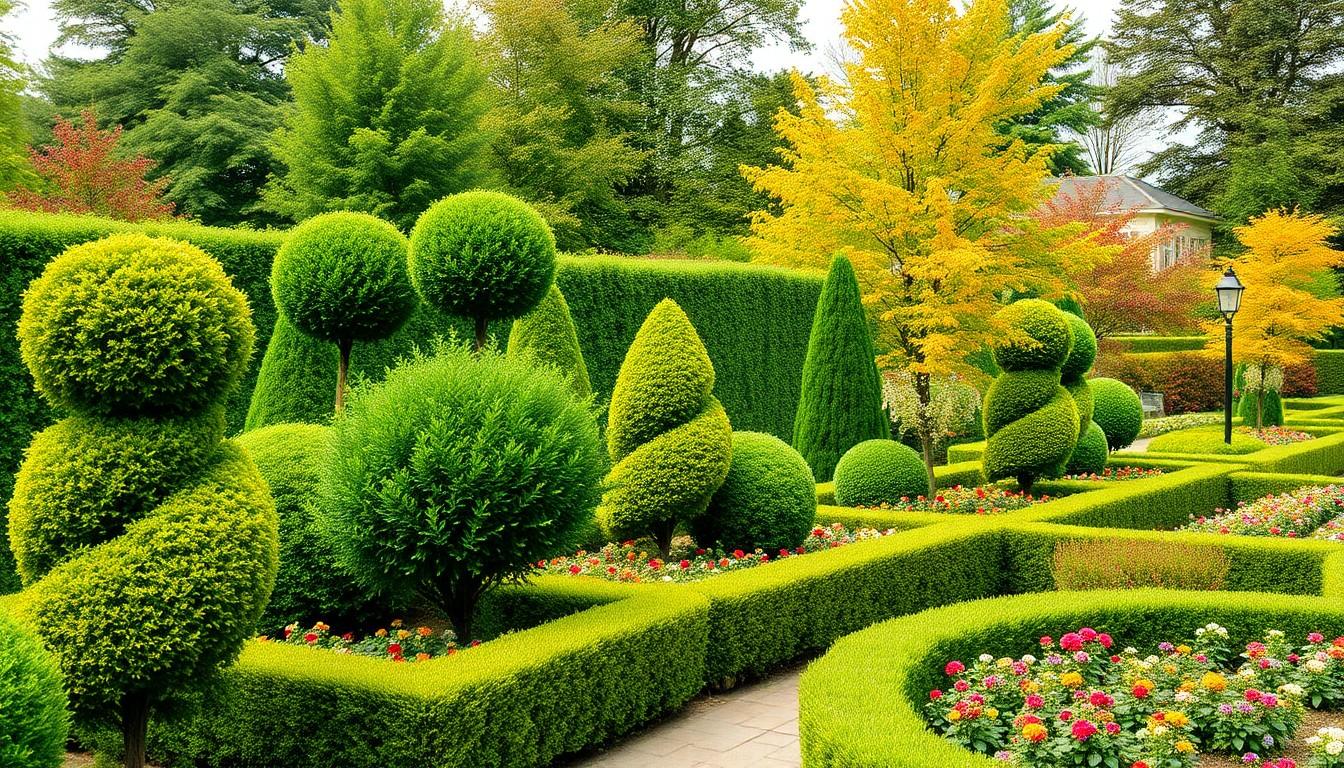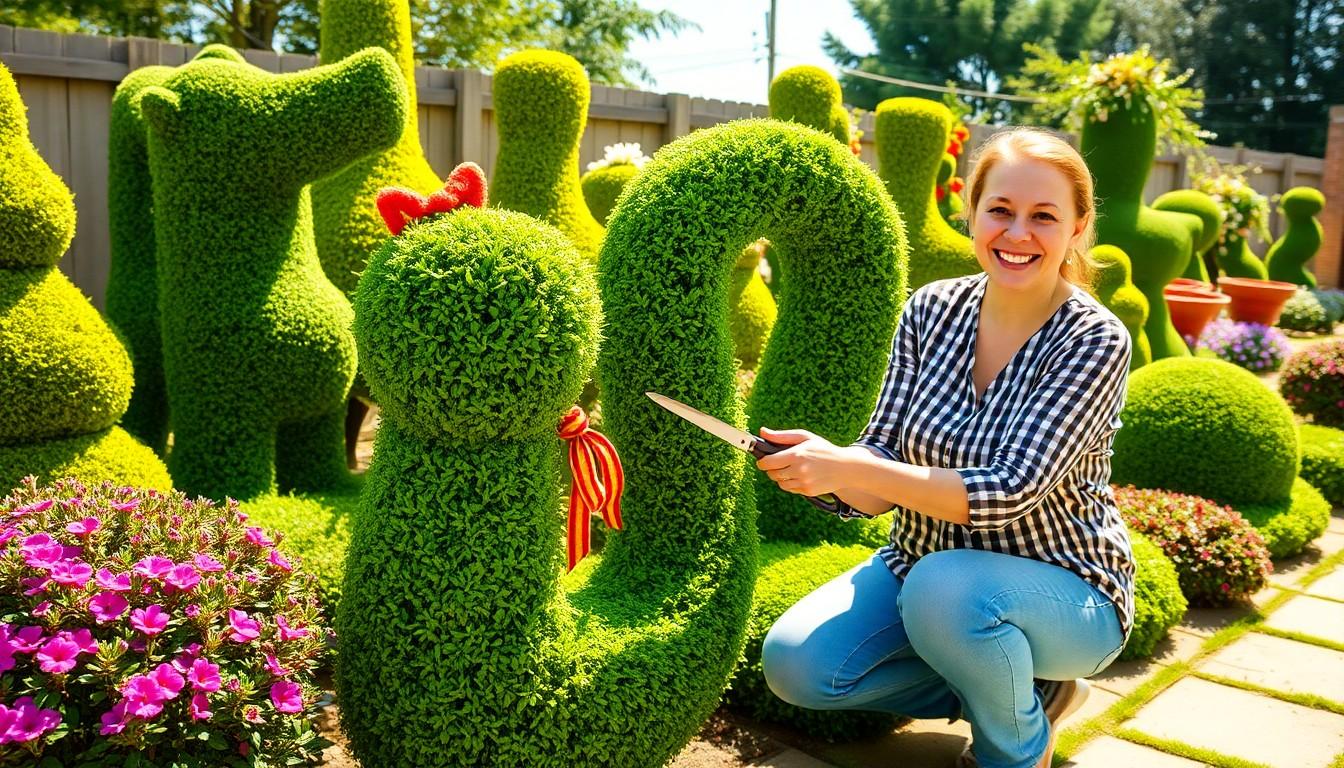Imagine stepping into a garden where plants don’t just grow—they perform. Outdoor topiary plants are the quirky stars of the horticultural world, sculpting nature into whimsical shapes that spark joy and conversation. From elegantly trimmed hedges to playful animal shapes, these living sculptures can transform any outdoor space into an enchanting retreat, especially when paired with thoughtfully designed outdoor flooring that enhances both aesthetics and functionality.
Overview Of Outdoor Topiary Plants
Outdoor topiary plants serve as distinctive features in gardens. These plants can be shaped into various forms, ranging from geometric shapes to intricate animal figures. Common plants used include boxwood, yew, and holly. Each plant type offers unique qualities that enhance their sculptural capabilities.
Creating outdoor topiary involves training young plants through regular trimming and pruning. This process allows gardeners to mold the plants into desired shapes. It requires attention and care to maintain the aesthetic appeal. Gardeners often employ sharp clippers and shears to achieve clean edges and defined shapes.
Topiary designs can vary significantly, catering to different tastes and styles. Some individuals prefer classic shapes like spirals or cones, while others enjoy more whimsical designs like animals or fantasy figures. These options allow for personal expression, making gardens more inviting and engaging.
Seasonal care is vital for topiary plants. Regular watering, feeding, and precise pruning promote healthy growth and maintain the desired form. During winter, protection against harsh weather conditions helps preserve the integrity of the sculptures. Mulching around the base can provide insulation and retain moisture.
Diverse garden themes integrate topiary elements seamlessly. Formal gardens often feature meticulously shaped shrubs, while modern landscapes may include abstract forms. Understanding the surrounding environment enhances compatibility and visual appeal. Overall, outdoor topiary plants enrich outdoor spaces, offering a blend of artistry and nature.
Types Of Outdoor Topiary Plants

Outdoor topiary plants come in various types, adding diversity and creativity to garden designs. Understanding the distinctions enhances the selection process for those interested in these living sculptures.
Evergreen Topiary Plants
Evergreen topiary plants maintain their leaves throughout the year, providing year-round structure and beauty. Boxwood, with its dense foliage, offers excellent options for intricate designs. Yew, another popular choice, tolerates heavy pruning and shapes easily. Holly presents a striking appearance with its glossy leaves and red berries, especially during the holiday season. Taxus and Ilex varieties also contribute vibrant greenery, making them ideal for classic topiary forms. Easy maintenance enables gardeners to enjoy their elegance without significant effort.
Deciduous Topiary Plants
Deciduous topiary plants provide seasonal interest as they change with the seasons. Plants like linden and maple exhibit stunning foliage colors during autumn, enriching outdoor spaces. The versatility of hornbeam allows for various shapes while providing vibrant summer greens and autumn hues. Willow, with its graceful branches, creates soft, flowing forms that stand out in gardens. Many deciduous options thrive in different climates, allowing for broad adaptability. Regular pruning ensures they maintain their desired shapes while offering a unique visual appeal throughout the year.
Popular Styles Of Topiary
Outdoor topiary plants come in various unique styles that enhance garden aesthetics. These styles cater to different tastes and design preferences.
Traditional Shapes
Classic forms remain popular in topiary. The spiral shape signifies elegance, adding a formal touch to any garden. Cone shapes offer a structured appearance, perfect for lining paths or framing entrances. Sphere shapes provide a balanced look, often used to create focal points amidst flower beds. These traditional designs maintain timeless appeal, emphasizing symmetry and meticulous care.
Contemporary Designs
Modern interpretations of topiary push creative boundaries. Abstract forms often feature exaggerated peaks and sweeping curves, providing a playful twist. Popular figures include geometric shapes, lending an artistic flair to landscapes. Whimsical animal shapes appeal to those seeking a fun, animated touch in their gardens. These contemporary designs integrate seamlessly with diverse garden themes, showcasing individual personality while still embracing the essence of topiary artistry.
Care And Maintenance
Maintaining outdoor topiary plants requires attention to detail and knowledge of their specific needs. Proper care ensures these living sculptures thrive.
Watering Requirements
Watering outdoor topiary plants differs based on the type and climate. Deep watering promotes healthy root growth, especially in dry seasons. Regular checks for soil moisture help determine when to water. It’s essential to avoid over-saturating the soil, as standing water can lead to root rot. Mulching around the base reduces evaporation and conserves moisture. Adjust watering frequency in colder months, as plants need less water.
Pruning Techniques
Pruning outdoor topiary plants shapes their forms and promotes healthy growth. Regularly trimming encourages dense foliage and maintains desired outlines. Use sharp, clean pruning tools to achieve clean cuts and reduce disease risk. Begin pruning in early spring when new growth appears, and continue throughout the growing season. Each cut should follow the natural form of the plant. Pay attention to the overall balance and symmetry, ensuring an aesthetically pleasing shape. Topiary forms require consistent care to maintain their unique sculptures.
Benefits Of Outdoor Topiary Plants
Outdoor topiary plants enhance aesthetic appeal in gardens. They create structured forms that attract attention and admiration from visitors. A variety of shapes, such as spirals and animal figures, contribute to a unique garden atmosphere.
Topiary plants provide year-round interest, especially evergreens like boxwood and yew. Seasonal changes in deciduous plants, such as maple and linden, add vibrancy throughout the year. These variations ensure gardens remain visually engaging with a blend of colors and shapes.
Plants like holly offer an additional benefit with their hardiness and adaptability across various climates. Regular pruning not only shapes the plants but also promotes healthy growth, making them resilient. This maintenance results in long-lasting topiary sculptures.
Sustainability plays an important role in choosing outdoor topiary plants. They often require minimal resources once established, making them an eco-friendly option for gardens. Their ability to thrive in limited space makes them suitable for small yards or patios.
Incorporating topiary elements can create a sense of balance and harmony within garden designs. Symmetrical shapes lend a formal touch while whimsical figures invite playfulness and creativity. This versatility caters to different styles, enhancing overall garden themes.
Moreover, topiary plants contribute to biodiversity and support local ecosystems. They provide habitats for various pollinators, such as bees and butterflies. Choosing diverse plant species enriches the garden and promotes ecological health.
Conclusion
Outdoor topiary plants offer a unique blend of artistry and nature that transforms gardens into captivating spaces. Their versatility allows for creative expression ranging from classic shapes to whimsical designs. With proper care and maintenance these living sculptures can thrive and enhance any outdoor area year-round.
By selecting the right types of topiary plants and incorporating them into diverse garden themes individuals can create stunning visual interest. The benefits extend beyond aesthetics as topiary plants contribute to ecological health and sustainability. Embracing topiary in gardening not only elevates the landscape but also fosters a deeper connection with nature.

